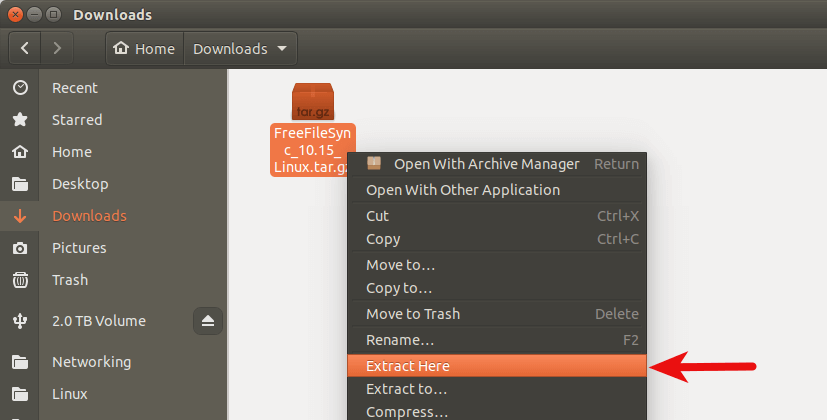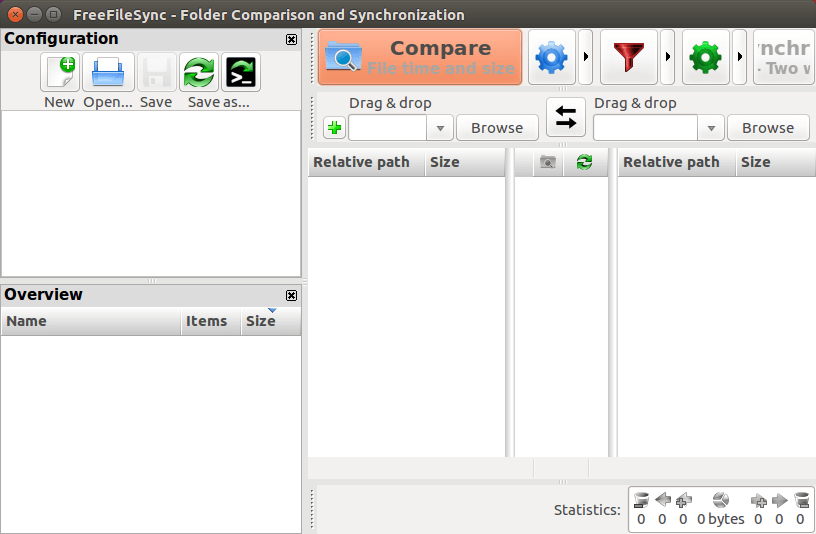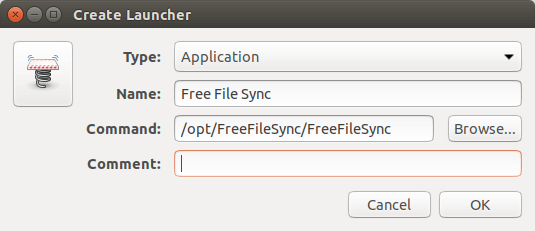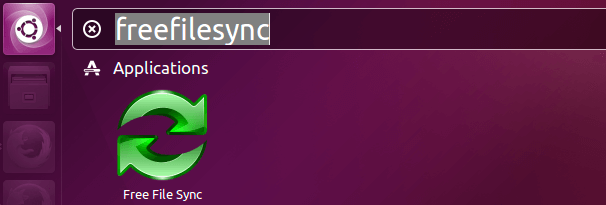How to Install FreeFileSync on Ubuntu 18.04, 19.04, 16.04
Dropbox, NextCloud, and syncthing are great tools for syncing files and folders between your computer, tablet and smart phone, but what about syncing files and folders on the same device? FreeFileSync is a free and open source file synchronization tool that fits this purpose. It can be used to back up your files to external USB hard drive. The latest stable version is 10.15, released on August 15, 2019. This tutorial shows how to install FreeFileSync on Ubuntu 18.04, 19.04 and 16.04.
Install FreeFileSync on Ubuntu 18.04, 19.04 and 16.04
FreeFileSync isn’t in Ubuntu repository and the official PPA isn’t maintained anymore. We need to manually download and install it. Go to FreeFileSync download page. Select the Linux version.

Once downloaded, open file manager, navigate to the download folder. Then right-click on the tar.gz file and select extract here.

The content will be extracted to a new folder FreeFileSync in the current folder. In that folder you will see two executable binaries: FreeFileSync and RealTimeSync.

Double-click the FreeFileSync binary and the program will run.

Create a Launcher
First, to keep the file system tidy and organized, move the FreeFileSync directory to /opt/, which is traditionally used to store third-party applications on Unix/Linux operating systems.
sudo mv FreeFileSync/ /opt/
Next, install Gnome Panel which allows us to create .desktop files.
sudo apt-get install --no-install-recommends gnome-panel
Run the following command to create a .desktop file in /usr/share/applications/ directory.
sudo gnome-desktop-item-edit /usr/share/applications/ --create-new
In the “Create Launcher” window, give the launcher a name and specify the command to execute (/opt/FreeFileSync/FreeFileSync).

Clicking the spring icon on the left allows you to choose an icon for the launcher (/opt/FreeFileSync/Resources/FreeFileSync.png). Then click OK button and now you can search FreeFileSync in your application launcher.

Source Folder and Target Folder
On the right pane, click the left Browse button to add the source folder. Click the right Browse button to add the target folder. Once it’s done, click the Synchronize button to start syncing files between source and target folder. You can also click the Compare button to see what’s the difference between the two folders.

Two-Way Synchronization vs Mirror Synchronization
By default, FreeFileSync uses two-way synchronization. That means changes made in either source or target folder will be synchronized to the other folder.
If you only want the target folder to replicate change from the source folder, but not the other way around, you can configure it to use mirror synchronization by clicking the green gear icon and selecting Mirror in the setting window. Click OK button. Now changes made in the target folder won’t be synchronized to the source folder.

Wrapping Up
I hope this tutorial helped you install and use FreeFileSync on Ubuntu 18.04, ,19.04 and 16.04. You may also want to read:
As always, if you found this post useful, then subscribe to our free newsletter to get more tips and tricks 🙂



Great! Works very well! Thank you!
I need some help: This is not an install. Is there a way to add it to the dash?
Hi, I updated the tutorial to include instructions on how to create a launcher for Free File Sync.
Thanks for the update!
I use it for moving large numbers of files. I feel it is so much safer than doing a simple cut and paste – Easier to track errors, especially in situations where subfolders are nested too deep. Plus, everything is visual or with GUI.
Hi, it works, but: I had to copy the files via “sudo nautilus”. When I close FreeFileSync I get the following message: The file /opt/FreeFileSync/GlobalSettings.xml can not be written. Error code 13: No authorization [open]. What is the problem? Thanks for help!
There is a useful option in FreeFileSync: Instruments -> Settings -> Copy rights (need administrator rights). To use it, you need to add “sudo” before command.
sudo sed -i ‘s/Exec=//Exec=sudo //’ /usr/share/applications/FreeFileSync.desktop
thank you. A pity this is not on their own site as it is not straightforward. Excellent instructions that worked! Hopefully snappy will end installation pain.
Ótimo tutorial!
Gratidão!
Thank you!!! I would like to see FreeFileSync put something like this on their website! I will start following your webpages now so it was a double good deal for me!
How to install it on Ubuntu 18.04?
I have been using your method to install FreeFileSync since I can remember, and it always worked, but with Ubuntu 19.10 I can’t create a launcher using the gnome panel. Can you help me?
Hi, is it possible to sync network drives. If yes, how to mount smb shares in order to be available for freefilesync ? Thank you.
This procedure does not work at all on Kubuntu!
I never said it will work on Kubuntu 🙂
I have no idea why in Ubuntu 19.10, after extracting, I cannot run the executable FreeFileSync despite having granted the permission to execute it. I double click and nothing happens, I launch via Terminal and says `FreeFileSync: command not found`
Any advice please?
ah, I found out. I didn’t have libgtk2.0 installed on my system.
cheers anyway!